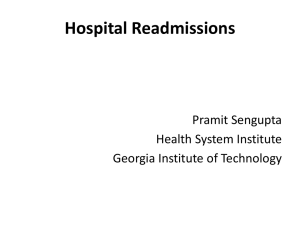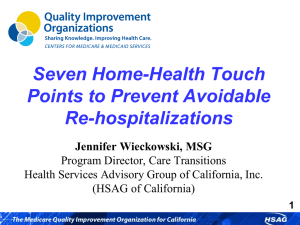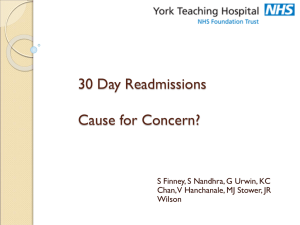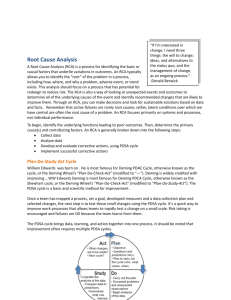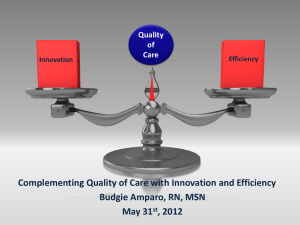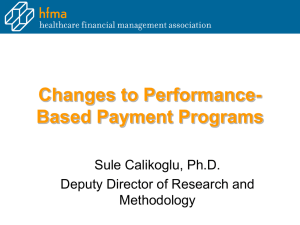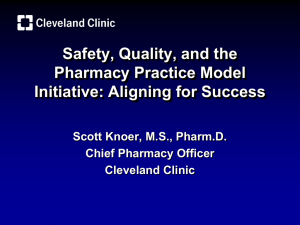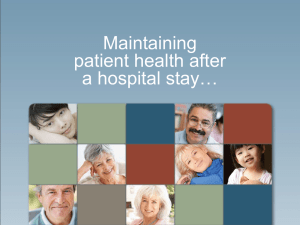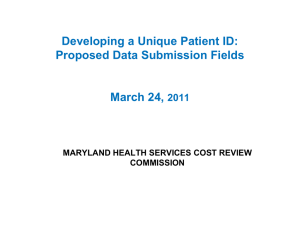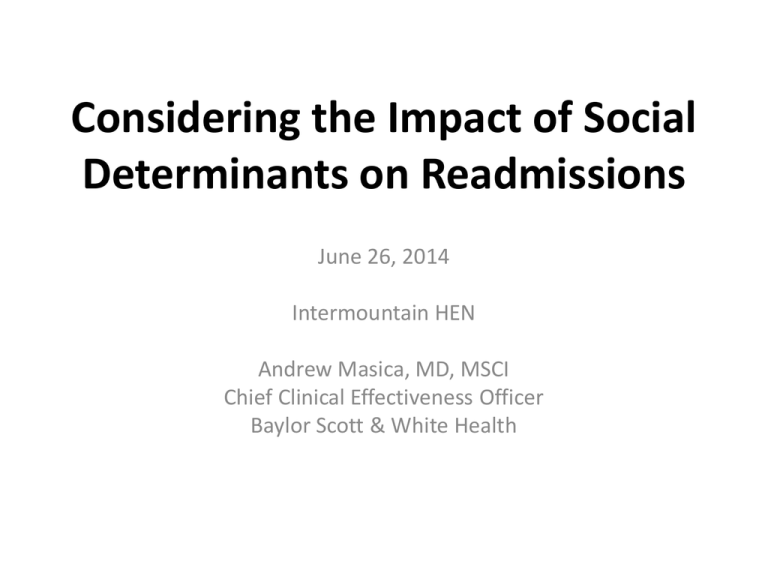
Considering the Impact of Social
Determinants on Readmissions
June 26, 2014
Intermountain HEN
Andrew Masica, MD, MSCI
Chief Clinical Effectiveness Officer
Baylor Scott & White Health
Readmissions
within 30 Days of Discharge
• Common, costly, & potentially hazardous
• Major focus in virtually all hospitals/systems
• Effectiveness of many suggested interventions
to reduce rates are often disappointing when
rigorously evaluated
• …literature clearly shows that ‘one size
does not fit all’ and implementation of
readmission strategies should be
accompanied by robust evaluations
(McAlister, 2013)
Leppin et al. JAMA Int Med 2014
Transitional Care Interventions to
Prevent HF Readmissions
• AHRQ-funded evidence report #133
• Examined 47 relevant trial-based studies
evaluating reported interventions
Intervention Type
Intensive Home Visits
Multidisciplinary HF Clinic
Structured Phone Support
Telemonitoring
Nurse-led Interventions
HF
Readmits
+
+
-
All Cause
Readmits Mortality
+
+
-
+
+
+
-
Understanding the relative effects
of social factors on reported
readmission rates may help
hospitals better target
improvement efforts at an
organizational level.
Nagasako et al., 2014
Association of SES with Readmissions
Joynt K, Jha AK NEJM 2013
Social Factors Influencing Readmission
(Cavillo-King et al.)
Considering Cause & Effect
• Readmission rate as a quality metric & basis for financial
penalties assumes that:
– Readmissions are a result of poor quality, clinical care after
adjustment for comorbidities and disease severity
• Socioeconomic factors at the patient and community levels
are shown to be related to the probability of readmission
– Individual level: Poverty, illiteracy, English proficiency, social
support
– Community level: poverty, housing vacancy, educational
attainment rates
• DebateShould we reformulate risk adjustment models
and penalties?
Selected References
•
•
•
•
•
•
•
Calvillo-King, L et al. “Impact of Social Factors on Risk of Readmission or Mortality
in Pneumonia and Heart Failure: Systematic Review,” J Gen Intern Med, 28(2):26982, 2013.
Feltner, C et al. Transitional Care Interventions to Prevent Readmission for People
with Heart Failure, Comparative Effectiveness Review #133, AHRQ Publication No.
14-EHC021-EF, Rockville, MD, May, 2014.
Hu, J. “Socioeconomic Status and Readmissions: Evidence form an Urban
Teaching Hospital,” Health Affairs, 33(5):778-785, 2014.
McAlister, FA. “Decreasing Readmissions: It Can Be Done But One Size Does Not
Fit All,” Qual Saf, 22:975-976, 2013.
Nagasako, EM et al. “Adding Socioeconomic Data to Hospital Readmissions
Calculations may Produce More Useful Results,” Health Affairs, 33(5):786-791,
2014.
Joynt KE, Jha AK. A path forward on Medicare readmissions. NEJM 2013;368:11751177.
Leppin A, et al. Preventing 30-day hospital readmissions: a systematic review and
meta-analysis. JAMA Int Med May 2014 (E pub)
Care Navigator Pilot Study at
Baylor Scott & White Health
Context
• Evidence to support the clinical benefits of
medical homes
• Less clarity surrounding the financial impacts of
these programs, particularly in underserved
populations
• Current health care market (shifts in
reimbursements, budget pressures, scarce
resources) precipitated a need to examine the
impact of the BSWH subsidized community clinics
• $50K of grant support awarded by the Irving
Healthcare Foundation to formally investigate this
question using a robust methodology
Baylor Irving Hospital
Inpt/Obs/ER Encounter
Pt. referral to Clinic Staff
Clinic Staff enrolls eligible pts.
Baseline data collected:
•Demographics
•Comorbidities
•Home status
•Other variables
BCC Irving Impact Evaluation
Study Design
“Unconnected”
(Pts. do not make follow-up visit)
Outcomes
Tracking
BCC Irving Medical Home
“Connected”
(Pts. establish follow-up in clinic)
Comparative
Analyses
1:3 Randomization
Usual Care + Care
Navigation Intervention
Usual Care
Outcomes
Tracking
Care Navigator Intervention-90 Days
Enrollment/Tracking Data
418 Eligible Patients Referred to BCC Irving Clinic December 2012-December 2013
341 Patients Established Clinic
Follow-up with Data Available for Analysis
77 Patients “Unconnected”
Randomization
86 Patients: Care
Navigator Intervention
255 Patients:
Usual Care
Follow-up Period
341 Patients (100%): 90 Days
332 Patients (97%): 180 Days
208 Patients (61%): 365 Days
Follow-up Period
77 Patients (100%): 90 Days
72 Patients (94%): 180 Days
40 Patients (52%): 365 Days
14
Table 2. Demographics
Summary - BCCCN vs. Usual
Study PopulationCN Intervention
vs.CareControl Group
Outcome
Category
Number
Age, mean (SD)
Age (category) 18-39
40-49
50-59
60+
Sex
Female
Male
Ethnicity
Hispanic
Non-Hispanic
Unknown
Race
Caucasian
African-American
Other
Home Status
Lives alone
Lives w/family
Lives w/others
Unknown
Marital Status Married
Single
Unknown
Substance
Yes
Abuse
No
Unknown
Substance
Alcohol
Other
Tobacco
Enrollment Group
A: BCCCN
B: Usual Care
86 ( 100)
255 ( 100)
45.0(11.3)
44.7(12.0)
26 ( 30.2)
86 ( 33.7)
28 ( 32.6)
75 ( 29.4)
26 ( 30.2)
71 ( 27.8)
6 ( 7.0)
23 ( 9.0)
50 ( 58.1)
142 ( 55.7)
36 ( 41.9)
113 ( 44.3)
44 ( 51.2)
112 ( 43.9)
42 ( 48.8)
141 ( 55.3)
0
2 ( 0.8)
71 ( 82.6)
208 ( 81.6)
10 ( 11.6)
41 ( 16.1)
5 ( 5.8)
6 ( 2.4)
4 ( 4.7)
18 ( 7.1)
76 ( 88.4)
214 ( 83.9)
6 ( 7.0)
17 ( 6.7)
0
6 ( 2.4)
29 ( 33.7)
110 ( 43.1)
48 ( 55.8)
130 ( 51.0)
9 ( 10.5)
15 ( 5.9)
9 ( 10.5)
35 ( 13.7)
71 ( 82.6)
6 ( 7.0)
5 ( 55.6)
2 ( 22.2)
2 ( 22.2)
199 ( 78.0)
21 ( 8.2)
14 ( 41.2)
8 ( 23.5)
12 ( 35.3)
* Comorbidities also similar between groups
P-value
.
0.50
0.83
0.69
0.38
0.20
0.43
0.16
0.66
0.70
15
Preliminary Results I: Care Navigator vs. Usual Care
Hospital Admissions Comparison for Patients with Established Clinic Follow-up
(Random Assignment to Care Navigator vs. Usual Care)
Randomization Group
Time (Days)
After Index Encounter
A: Care Navigator
B: Usual Care
30
2.3 ( 2 / 86) 5.9 ( 15 / 255)
60
3.5 ( 3 / 86) 9.0 ( 23 / 255)
90
4.7 ( 4 / 86) 12.2 ( 31 / 255)
*Care Navigator Intervention was 90-days in duration
180
15.7 ( 13 / 83) 15.7 ( 39 / 249)
365
17.3 ( 9 / 52) 22.4 ( 35 / 156)
Changes
P-value
Absolute Diff. % Change
0.190
0.095
0.047
-3.6
-5.5
-7.5
-60.5
-61.3
-61.7
1.000
0.433
0
-5.1
0
-22.9
• P<0.05 considered as statistically significant
• Number of CN interventions needed to prevent 1 hospital admission (1/.075)= 13
Masica et al. BSWH internal data
16
Preliminary Results II: Incremental Benefit of Support
Hospital Admission Rate at 90-days after Index Encounter per 100 patients
Unconnected
Connected
Connected + CN
28.9
13.5
4.7
Hospital Admission Rate at 365-days after Index Encounter per 100 patients
Unconnected
Connected
Connected + CN
76.1
50.5
54.1*
*Care Navigator Intervention was 90-days in duration
Masica et al. BSWH internal data
Discussion Points
• For patients establishing clinic follow-up, the Care
Navigation intervention reduced hospital
utilization rates at 90-days compared to usual
care (matching the duration of the intervention)
• Hospital admission utilization converged between
groups during the extended follow-up period
without the Care Navigation intervention
• This intervention was successful in a high-risk
population
18
Next Steps at BSWH
• Collect remaining follow-up data through 12/14
• Cross-check readmissions with DFW Hospital
Council database and assess subgroups
• Statistical adjustments
• Cost-effectiveness analyses
• Share the story with the outside world
-National meetings, journal publication
• Consider operational use of care navigators at the
community clinic sites
19
Open Forum
We have reached our Gooooaaal!
30 Day All Cause Readmissions
We have reached our Gooooaaal!
30 Day Medicare Readmissions
Data Tables
30 Day All Cause Readmissions
30-Day All Cause Readmission
Q1 2012 Q2 2012 Q3 2012 Q4 2012 Q1 2013 Q2 2013 Q3 2013 Q4 2013 Q1 2014
Numerator
16052 15368 14841 14046 15113 14524 14373 12740
9978
Denominator 179562 176592 174041 165931 182761 177490 176665 160883 142338
Rate
8.94
8.7
8.53
8.46
8.27
8.18
8.14
7.92
7.01
Baseline
8.83
8.83
8.83
8.83
8.83
8.83
8.83
8.83
8.83
30 Day Medicare Readmissions
30-Day Medicare Readmission
Q1 2012 Q2 2012 Q3 2012 Q4 2012 Q1 2013 Q2 2013 Q3 2013 Q4 2013 Q1 2014
Numerator
6432
6117
6543
6374
7375
6831
6862
5980
4518
Denominator 53104 50692 55491 55463 66083 61179 60456 54694 45962
Rate
12.11 12.07 11.79 11.49 11.16 11.17 11.35 10.93
9.83
Baseline
12.36 12.36 12.36 12.36 12.36 12.36 12.36 12.36 12.36
Reminders
July 11:
Falls & Immobility Affinity Call
July 18:
Leadership-Followership Webinar
August 13: CLABSI Affinity Call
Additional information available on the website at:
http://www.henlearner.org/about/calendar/

